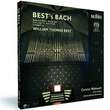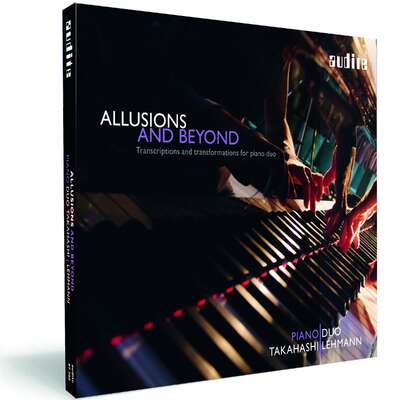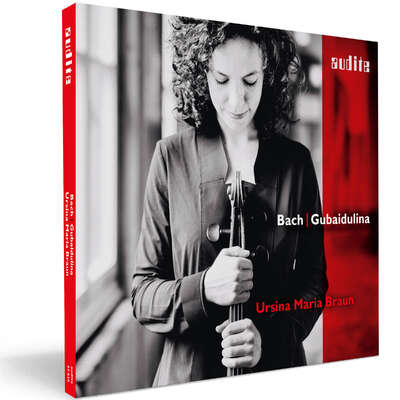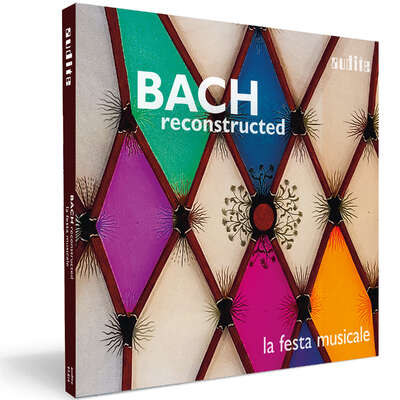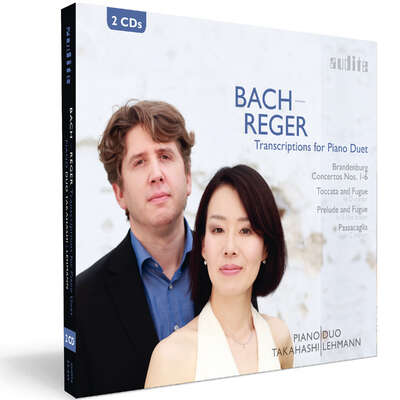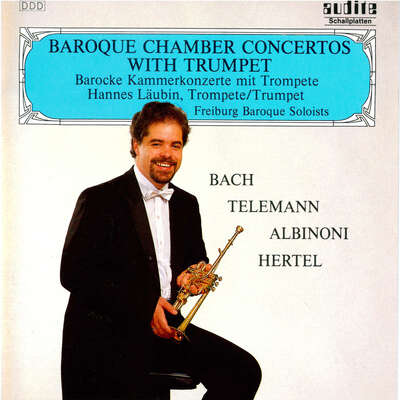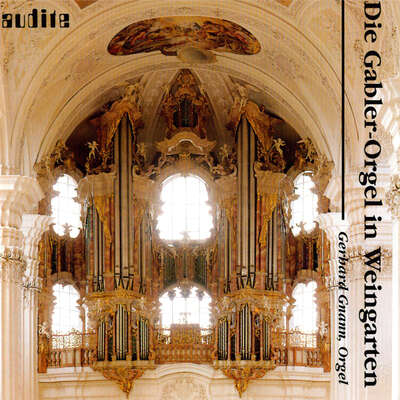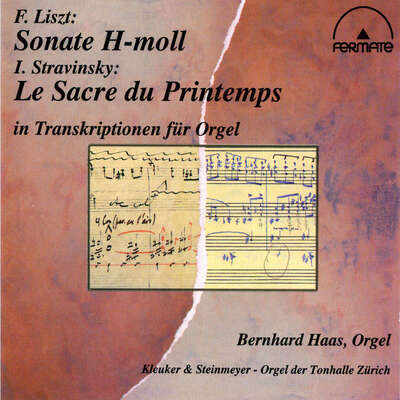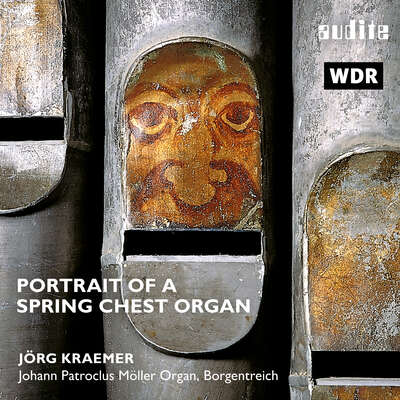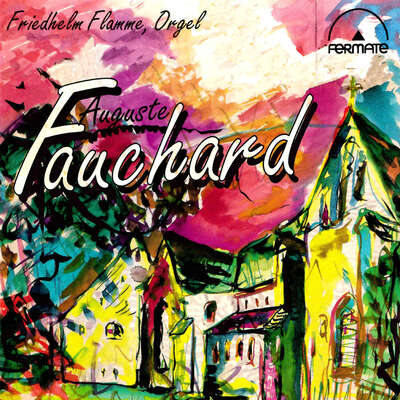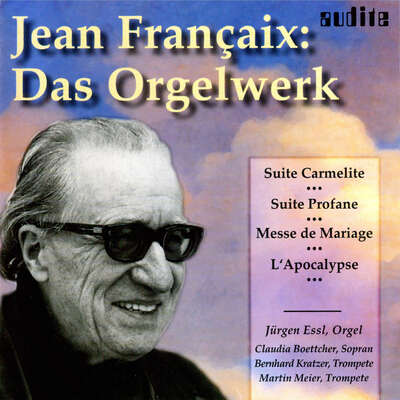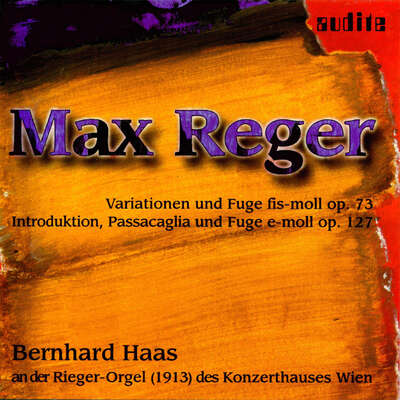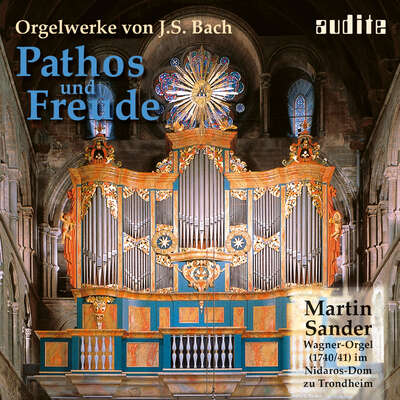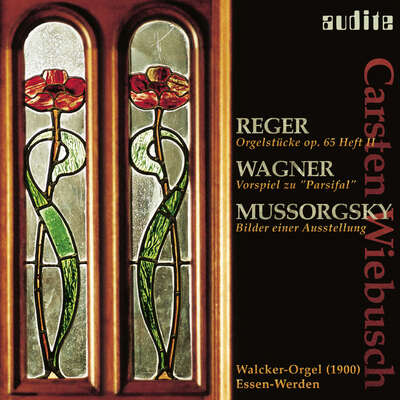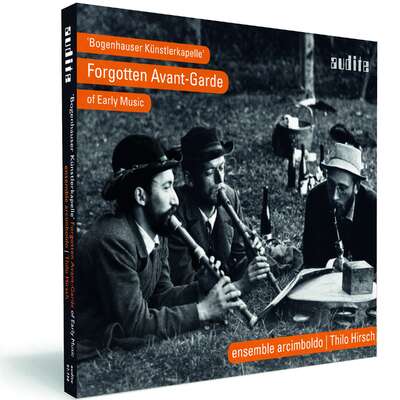
In this SACD William Thomas Best (1826-1897), with his arrangements of selected organ works and the Chaconne for Solo Violin by Bach, makes his appearance as a dramatic director: his stage directions in matters of choice of tempo, articulation, registration, selection of manuals and, where appropriate, the use of the swell pedal, enable the great free-standing organ works to appear as dramatic scenas or ballads, while the smaller-scale works and chorale preludes come across as poetry. Carsten Wiebusch dramatises Bach on the new Klais organ in the Christuskirche, Karlsruhe, in a way that is both poetic and powerful.more
In this SACD William Thomas Best (1826-1897), with his arrangements of selected organ works and the Chaconne for Solo Violin by Bach, makes his appearance as a dramatic director: his stage directions in matters of choice of tempo, articulation, registration, selection of manuals and, where appropriate, the use of the swell pedal, enable the great free-standing organ works to appear as dramatic scenas or ballads, while the smaller-scale works and chorale preludes come across as poetry. Carsten Wiebusch dramatises Bach on the new Klais organ in the Christuskirche, Karlsruhe, in a way that is both poetic and powerful.
Details
|
Best's Bach
Selected Organ Works and Chaconne for Solo Violin arranged by William Thomas Best |
|
| article number: | 92.663 |
|---|---|
| EAN barcode: | 4022143926630 |
| price group: | ACX |
| release date: | 30. March 2012 |
| total time: | 73 min. |
Informationen
“We must hope that that time is over in which these works, which are so full of deepest poetry and feeling, knew only one style of performance, only one and the same noisy, barbaric manner of playing.” (Foreword to William Thomas Best’s edition of Bach’s organ works)
In the musical life of today, after several epochs of a free approach to instrumentation, arrangement and other “external” details of a composition, it seems that only an historically authentic interpretation is thought acceptable – performers play from facsimiles or original scores, and historically accurate orchestration, articulation, etc, fulfil a major role.
This recording of selected works by Bach in organ arrangements by William Thomas Best (1826-1897) gives evidence of an approach to Bach’s compositions that may seem quite capricious today. Alongside his arrangement of Bach’s Chaconne for violin from the Partita no. 2 in D minor, this SACD presents highlights from his comprehensive edition of Bach’s organ works, from chorale preludes to the C minor Passacaglia.
In his editions and arrangements Best saw it as his mission, particularly for an English audience which was entirely unfamiliar with Bach’s works, to provide the organist with what amounts to stage directions in matters of choice of tempo, articulation, registration, selection of manuals and, where appropriate, the use of the swell pedal. In this way the great free-standing organ works appear as dramatic scenas or ballads, while the smaller-scale works and chorale preludes come across as poetry.
Best achieves a convincing dramatic presentation of Bach’s music: by means of refined, well-placed tricks of the trade the poetic meaning of individual passages is made apparent, and his economy of means and avoidance of all superficial effects enable the grandiose form of each work to come to the fore. The performance indications (or rather suggestions) are presented in such a way that the organist is amply challenged as a musician, interpreter and personality at all times.
Carsten Wiebusch studied church music at the Robert Schumann Hochschule in Düsseldorf. As an organist he achieved success at international organ competitions including the August Gottfried competition in Magdeburg and the Johann Sebastian Bach prize competition in Wiesbaden, both in 1995. He teaches an organ class at the Musikhochschule in Karlsruhe and has been organist at the Christuskirche, Karlsruhe, since 1999.
The Klais organ at the Christuskirche was inaugurated in 2010. Its powerful yet poetic tone is heard in this SACD for the first time in any recording.
Reviews
www.michael-pfeifer.de | 28.02.2015 | Michael Pfeifer | February 28, 2015 Bach neu hören
Eine analytische, dabei aber unmittelbar zugängliche und höchst musikalische Art, auf der die Bachschen Orgelwerke nun daherkommen. [...] Best's Bach ist seit langem der beste Bach, der zu hören war.Mehr lesen
www.amazon.de | 31. März 2013 | Gottfried Meyer | March 31, 2013 Dauerthema: Bach und die Orgel
Durch eine Sendung in BR-Klassik wurde ich auf die CD aufmerksam gemacht. Dem Thema Orgel gilt mein Interesse und da der Interpretation derMehr lesen
Die Einspielung von Wiebusch auf einer modernen Klais-Orgel geht nun noch weiter weg von einer historisch angelehnten Aufführungspraxis, die Instrumente aus der Zeit Bachs bevorzugt, vielleicht auch welche, auf denen Bach gespielt hat und ihnen ein gutes Zeugnis ausgestellt hat. Ein Vergleich ist sehr interessant und ist jedem Orgelliebhaber zu empfehlen. Schult es doch sein kritisches Zuhören.
Wie heute in der Regel bei guten Firmen üblich, ist ein ausführliches Booklet beigefügt, das über Anliegen der Einspielung und das Instrument Auskunft gibt. Eine verwendete Registrierung bei den einzelnen Kompositionen anzugeben, wäre wünschenswert.
Bayern 4 Klassik - CD-Tipp | 21.01.2013 | Matthias Keller | January 21, 2013 Carsten Wiebusch spielt "Best's Bach"
William Thomas Best, geboren 1826 im englischen Carlisle, gestorben 1897 in Liverpool, war der erste englische Organist, der sich mit dem Werk JohannMehr lesen
Best ist damit vor Karl Straube der wohl wichtigste Bach-Exeget der Romantik. In seiner Bach-Ausgabe, der die erste Bach-Gesamtausgabe Wilhelm Rusts zugrunde liegt, ist keine einzige Note der ursprünglichen Vorlage geändert, wohl aber deren Lesart. Eben hierin liegt der Hauptaspekt dieser Neueinspielung: Sie ist ein Blick in die Interpretationsgeschichte des Bach'schen Orgelwerkes. Das mag zunächst befremden – in einer Zeit, die sich dem Urtext und Erforschen sogenannter historischer Aufführungspraxis verschrieben hat.
Orgel als Farbmalkasten
Andererseits liegen inzwischen auch vergleichbare Einspielungen vor etwa von Mendelssohns Fassung der "Matthäuspassion" oder Mozarts Version des Händel'schen "Messias". Best hat, darin ganz Kind seiner Zeit, das Interpretentum als ein mitschöpferisches betrachtet und sich wie selbstverständlich das Recht heraus genommen, Bachs Musik seinen persönlichen dynamischen und agogischen Vorstellungen zu unterwerfen und die Orgel hierbei als orchestralen "Farbmalkasten" zu benutzen. Deshalb beginnt bei ihm die d-Moll Toccata auffallend zart, wechselt in der großen c-Moll-Passacaglia die Registrierung mitunter taktweise, wie auch das Crescendo-Pedal vielerorts zum Einsatz kommt.
Echter Bach alla Best
Eine Bach-Inszenierung also, vergleichbar dem modernen Regietheater, welches sich ja ebenfalls das Recht heraus nimmt, konkret Überliefertes neu zu deuten. Interpret Carsten Wiebusch vollzieht diese Anweisungen aufs Genaueste und zeigt dabei, dass auch auf einer vergleichsweise "modernen" Klais-Orgel (Christuskirche Karlsruhe) "echter" Bach alla Best möglich ist.
Organ | 03/2012 | Wolfgang Valerius | September 1, 2012
Tut sich was in Orgel-Deutschland? Nach den Jahrzehnten eher eingefahrenerMehr lesen
Fidelity | Nr. 3, 5/2012 | Michael Rassinger | August 30, 2012 Bach neu gewandet
Einspielungen von Orgelwerken Johann Sebastian Bachs gibt es wahrlichMehr lesen
klassik.com
| 24.06.2012 | Thomas Bopp | June 24, 2012 | source: http://magazin.k...
Breit gestreutes Klangkaleidoskop
Bach, Johann Sebastian – Orgelwerke, bearbeitet von William Thomas Best
Bachs Orgelwerke und eine Orgeladaption der Chaconne für Violine soloMehr lesen
www.klavier.de
| 24.06.2012 | June 24, 2012
Breit gestreutes Klangkaleidoskop
Bach, Johann Sebastian: Orgelwerke, bearbeitet von William Thomas Best
Bachs Orgelwerke und eine Orgeladaption der Chaconne für Violine soloMehr lesen
www.opusklassiek.nl | mei 2012 | Siebe Riedstra | May 1, 2012
Bach en de waan van de dag – het blijft een fascinerend verschijnsel.Mehr lesen
Fono Forum | Mai 2012 | Friedrich Sprondel | May 1, 2012
Wege zu Bach
Bach nahm so viele Einflüsse in seine Orgelmusik auf, dass sich einem neugierigen Interpreten viele Wege zu ihm auftun – und manche Aufnahme zeigt, dass auch noch neue zu begehen sind
Die Britin Margaret Philips bringt ihre Bach-Gesamteinspielung in Doppelfolgen heraus; jede Scheibe ist dabei einem prominenten Instrument gewidmet.Mehr lesen
Das kann auch für den Leipziger Thomasorganist Ullrich Böhme gelten. Zuletzt hat er sich die großen Orgelchoräle vorgenommen, die Bach in seinen späten Leipziger Jahren in einer Sammelhandschrift zusammenfasste. Jedem Choral stellt Böhme einen Bach'schen Choralsatz voran, gespielt auf der kleinen Hildebrandt-Orgel von 1723 in Störmthal, einem kraftvoll-herben Instrument, das Bach bekannt war. Den jeweiligen Orgelchoral – oder die zugehörige Werkgruppe – spielt Böhme dann auf der großen "Bachorgel" der Leipziger Thomaskirche, die Gerald Woehl im Bachjahr 2000 fertigstellte. Beide Instrumente wurden mit vorteilhafter Direktheit aufgenommen und die farbenreiche, klangmächtige neue Orgel kann neben der charakterstarken alten gut bestehen. Ein Vergnügen aber ist, zu erleben, wie die "Bachorgel" den Thomasorganisten offenbar inspiriert. Er artikuliert und registriert, bei straffen Tempi und absoluter Klarheit, mit umwerfender Spielfreude. Die höchst anspruchsvolle Sammlung wird in ihrem stilistischen Reichtum unmittelbar erlebbar: als packende Musik.
Martin Neu möchte in seinen beiden Einspielungen Bach aus der Perspektive der nord- und süddeutschen Orgelkunst des 17. Jahrhunderts sichtbar machen. Er hat sich stilistisch adäquate Instrumente ausgesucht: Die Ahrend-Orgel in Herzogenaurach überzeugt mit warm-artikuliertem Klang und gibt dem norddeutschen Repertoire – hier beschränkt auf Bachs unmittelbare Bekanntschaften Böhm und Buxtehude – lebhafte Farbigkeit; beim süddeutschen – Kerll, Muffat, Froberger und Pachelbel – nutzt Neu die intensiv strahlende Metzler-Orgel in Obertürkheim für Pedaliter-Kompositionen, die Bernauer-Orgel in Laufenburg von 1776 mit ihrem satt-obertönigen Klang für die Manualiter-Musik. Hörbar inspiriert vom lebendigen Klang der Instrumente, spielt Neu stilistisch angemessen, übertreibt weder Tempi noch Artikulation und registriert oft betont schlicht, aber dank charaktervoller Einzelstimmen musikalisch sehr ergiebig. Die suggerierte Abhängigkeit begründet Neu im Booklet-Text einleuchtend; doch wird vor allem deutlich, wie stark Bach das Aufgenommene jeweils um- und sich anverwandelte.
Carsten Wiebusch geht einen Schritt weiter, indem er sich vornimmt, Bach gleichsam durch die Ohren eines anderen zu präsentieren: Er hält sich an die Ausgaben, die der Brahms-Zeitgenosse William Thomas Best mit Spielanweisungen für den modernen Konzertorganisten und seine technisch fortgeschrittene Orgel versehen hatte. Wiebusch präsentiert damit jene Klangressourcen, die die Klais-Orgel der Karlsruher Christuskirche hinzugewann, als sie kürzlich renoviert wurde. Dabei wurde die schlanke Sechziger-Jahre-Disposition um romantische Farben erweitert, die sich in der gelungenen Aufnahme durch große Intensität nachdrücklich bemerkbar machen. Schärfe und Fülle zusammen ergeben eine expressive Klangpalette, die Wiebusch nutzt, um den Best'schen Interpretationen dramatisches Profil zu verleihen – auch den Überraschungen, die in pièces de résistance wie der Passacaglia und der d-Moll-Toccata auf den Hörer warten. Dabei spielt Wiebusch selber überaus charakteristisch: Er meidet schwülstiges Romantisieren, artikuliert deutlich und lässt auch über die Tempobeugungen hinweg den rhythmischen Fluss nie abreißen. Wiebuschs Bach holt sich letztlich bei W. T. Best die Lizenz für ein expressiv gesteigertes Bach-Spiel – das als solches zweifellos überzeugt.
kirchmusik.de | 25.04.2012 | Rainer Goede | April 25, 2012
Natürlich, wer kauft heute noch eine Bach-CD in barocker PraxisMehr lesen
Der neue Merker
| April 2012 | April 1, 2012
audite – “BEST’S BACH”/Orgel
“BEST’S BACH” – Selected Organ Works & Chaconne for Solo Violin arranged by Wiliam Thomas Best – Carsten Wiebusch (Orgel) an der Klais-Orgel der Christuskirche Karlsruhe
Auf dieser SACD erscheint William Thomas Best (1826 – 1897) mit seinenMehr lesen
International Record Review | April 2012 | Peter Lynan | April 1, 2012
William Thomas Best presided for almost 40 years at the large Willis organ in St George's Hall, Liverpool, where he helped to define the role of theMehr lesen
Anyone expecting Best's Bach to be the organ equivalent of Leopold Stokowski's phantasmagorical orchestrations may be surprised. His editions aren't scholarly in the modern sense, but Best was a careful, even sensitive editor, resulting in performances that are often fairly modest and restrained rather than extravagant. Of course, they are overlaid with the interpretative values of the day, and it's in these details – the registration, articulation and tempos, for example – that the interest lies.
The chorale preludes can sound quite lean. In Liebster Jesu and Herzlich tut mich verlangen there is less rather than more ornamentation of the melody to be relished – it all sounds a little plain, in fact – and the former is taken much faster than it is usually played nowadays. Elsewhere, too, less often does seem to mean more for Best. The great Passacaglia is played not with organo pleno throughout but as a series of differently coloured, often delicate variations that, to Best at least, must have seemed the most effective way to elucidate the work's structure. This is much the same approach as in his well-known arrangement of the Chaconne in D minor, originally for violin, which in this context now appears less a oneoff piece of showmanship than a serious study of musical form.
Best's interpretations transform familiar works in a way that can sound strange to modern ears. To hear the Passacaglia and the Toccata and Fugue in D minor fading away on soft flue stops is very odd indeed, the unexpected, quiet endings becoming a means of dissipating the preceding fugal tensions rather than fulfilling their more familiar climactic function. The 'little' Prelude and Fugue in E minor too is quite understated, its fugue turned into a meditative afterthought for flutes and undulating strings.
Unless listening with Best's editions to hand, it will sometimes be difficult to disentangle the interpretational input of editor and performer. Carsten Wiebusch follows most of Best's suggestions to a T, but I detect a few (minor) departures from the score. He ignores the different flat and natural upper notes of the long trills in the fugue of the Toccata and Fugue and some of his tempos don't match Best's recommended metronome marks. Best doesn't articulate the usually swinging 6/8 fugue subject of the Toccata, Adagio and Fugue as if in 3/4, but that's how Wiebusch plays it, and the result is square and awkward.
Wiebusch pre-empts criticism of his choice of instrument by citing Best's interpretative freedom as justification: he sees it as no disadvantage that the Klais organ of the Christuskirche, Karlsruhe, has a tautness and tang to its tonal qualities that are a world away from the luscious, orchestrally conceived town hall organ Best played. He seeks authenticity in Best's ideas rather than in trying to reproduce more precisely Best's sound, which he argues does not lie at the heart of the matter. I'm sure there are those who would disagree, given that Best's ideas must have been informed at least in part by the type of organ he played. Some of the differences are regrettable, such as the Clarinet solo in the Adagio of the Toccata, Adagio and Fugue, which is assigned to a rather thin-lipped reed with mutation overtones in the absence of a nice rounded orchestral clarinet. Nevertheless, putting aside tricky questions of authenticity, the Klais is a fine, enjoyable instrument with some lovely, freshsounding voices, and it is very well recorded.
This is a curious disc. While I'm intrigued to hear Best's take on Bach (or should that be Wiebusch's take on Best), neither the instrument nor the arguments in its favour really win me over, and I'm left wondering how close to Best this recording really brings us.
Badische Zeitung | Samstag, 31. März 2012 | Johannes Adam | March 31, 2012
Orgelwerke aus Karlsruhe
Wo Bach zum Briten wird
Man muss sich umstellen. Dass Bachs Orgel-Passacaglia leise beginnt, ist einem ja noch geläufig. Kaum dagegen, dass sie auch verhalten ausklingt.Mehr lesen
Badische Neueste Nachrichten | Samstag, 09. Juni 2012 | aß | June 9, 201
Bach auf Englisch
Neue CD mit Musik des Thomaskantors
Bachs Orgelmusik ist geistvoll, vielschichtig, intelligent und tiefMehr lesen
